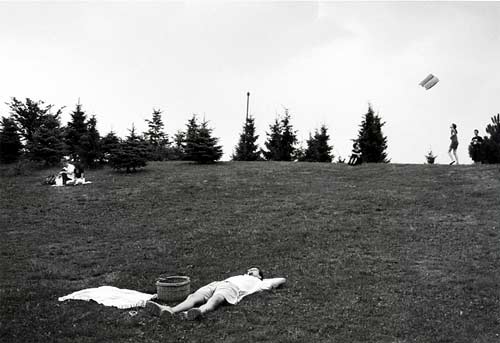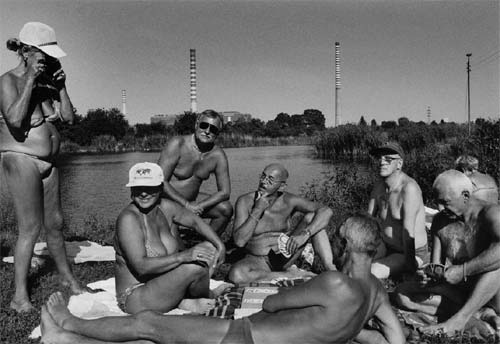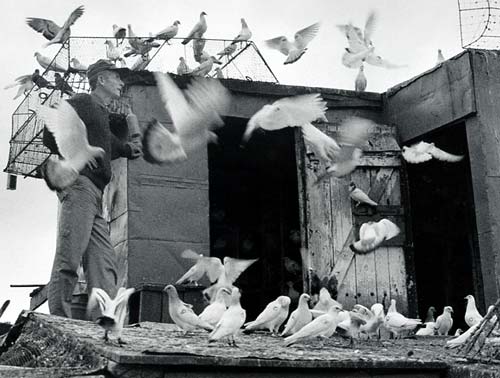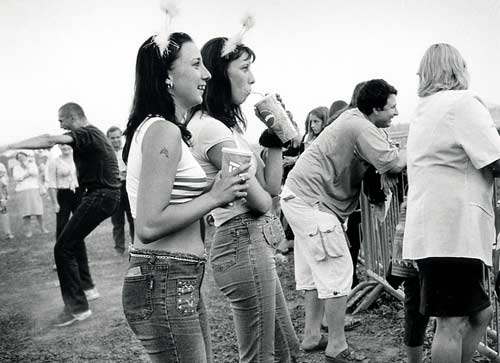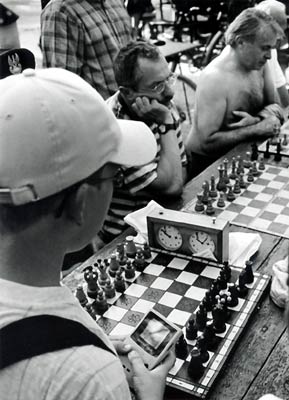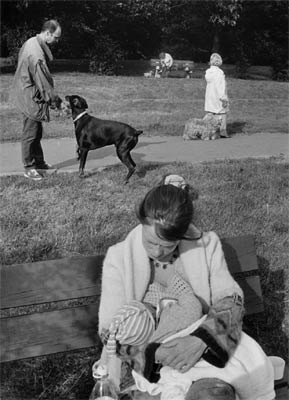Stara Galeria ZPAF
Warszawa, Pl.Zamkowy 8
od 27 sierpnia do 7 września
Grzegorz Gałęzia: "Warszawiaków portret niedzielny"
Grzegorz Gałęzia - "Warszawiaków portret niedzielny", wystawa w Starej Galerii ZPAF, wrzesień 2003
Amator
W kilku współczesnych słownikach wyrazów obcych nie znalazłam w ogóle objaśnienia słowa „amator”. Widocznie słowo to jest już dzisiaj ogólnie znane i rozumiane jednoznaczne. Jednak jeżeli mówimy o kimś „amator” brzmi to na ogół pejoratywnie. W potocznym rozumieniu – nie umiejący, nie wykształcony, nie profesjonalny... jednym słowem: amator. Zapominamy zupełnie o pięknym łacińskim źródłosłowie tego pojęcia, którym jest słowo „amare” – kochać. W wydanym w 1939 roku słowniku wyrazów obcych Trzaski, Everta i Michalskiego objaśnienie jest takie: „amator, ł. miłośnik, zwłaszcza sztuki, zwolennik, człowiek zajmujący się czymś niezawodowo”.

Grzegorz Gałęzia, jest z zawodu tłumaczem z języka angielskiego. Od lat zajmuje się też fotografią. Jest autorem paru wystaw, zdobywcą kilku nagród w konkursach fotograficznych, autorem wielu publikacji i artykułów, ilustrowanych jego własnymi zdjęciami. Jest też współautorem dość niezwykłej książki, o ludziach, którzy przeżyli hitlerowskie obozy koncentracyjne. Niedawno został członkiem Związku Polskich Artystów Fotografików.
Grzegorz Gałęzia jest szczególnie uczulony na tematy miejskie. Lubi obserwować ludzi w mieście, widzi ich w różnych zabawnych sytuacjach. Jego spojrzenie jest łagodne i pogodne, raczej przyjazne człowiekowi z jego różnym słabostkami i śmiesznostkami. Chociaż często podpatruje ludzi w sytuacjach zabawnych, nie czuję w jego zdjęciach złośliwości ani, tak typowej dla dzisiejszych profesjonalistów, pogoni za sensacją. Gałęzia ma natomiast duże wyczucie sytuacji dziwnych, z pogranicza surrealizmu. Prezentowane na wystawie zdjęcia pokazują nam Warszawiaków w różny sposób spędzających czas wolny w swym mieście. Zdjęcia te zostały zrobione w ciągu ostatnich kilku latach. Podkreślam to ponieważ obraz „warszawiaka niedzielnego”, jaki się z nich wyłania jest zaskakujący. Okazuje się, że mieszkańcy stolicy nadal lubią spędzać wolne chwile tak, jak robili to dwadzieścia i pięćdziesiąt lat temu. Piknik nad Wisłą, łowienie ryb w jej starorzeczu, brydżyk nad Jeziorkiem Czerniakowskim, spacerek w parku, wizyta na Starym Mieście. Zaś sposób, w jaki autor ich sfotografował też jest jakoś rozczulająco staroświecki. Zdjęcia są czarno-białe, w optyce raczej tradycyjnej /standard lub średniodługi obiektyw/, bez żadnych specjalnych efektów, czasami czuje się w nich nawet pewne niezdecydowanie. Można powiedzieć właśnie „amatorskie” To znaczy zrobione tylko dlatego, że autora zainteresował ten temat, że nie musiał się śpieszyć i mógł w wolnych chwilach poświęcić na to tyle czasu, ile chciał, że mógł zupełnie swobodnie podejść do tematu, i że nie musiał koniecznie zrobić zdjęć na rozkładówkę.
Żyjemy w czasach obowiązkowego profesjonalizmu. Trzeba, być bardzo dobrym, wypada być super zawodowcem. Wszyscy się strasznie śpieszą, żeby zdążyć przed konkurencją. Mało kto pozwolić sobie może na nieśpieszny krok, niezdecydowanie, bezpretensjonalna prostotę. Być może jest to już tylko przywilej amatorów, miłośników, tych co kochają...
Anna Beata Bohdziewicz
Grzegorz Gałęzia - "Warszawiaków portret niedzielny", wystawa w Starej Galerii ZPAF, wrzesień 2003
The Amateur
Although I looked in several contemporary dictionaries I could not find any definition of the word „amateur”. It seems that today the word is too well known and its meaning incontestable. If, however, we call somebody an „amateur”, it generally sounds pejorative. In the common understanding it means incapable, uneducated and unprofessional… in one word: an amateur. We entirely forget the beautiful Latin root of this term, which is amare – to love. In Trzaska, Evert and Michalski’s dictionary of foreign terms from 1939 the definition is the following: „amateur [Latin], lover, particularly of art, devotee, person involved in something non-professionally”.
Grzegorz Gałęzia is, by profession, an English translator and interpreter. For several years he has been involved in photography. He has held several exhibitions, won a number of prizes in photographic competitions, and has not only written publications and articles but illustrated them with his own pictures. He is also a co-author of a most unusual book with the portraits of Nazi concentration camp survivors. Recently he has become a member of the prestigious Polish Art Photographers Association.
Grzegorz Gałęzia is particularly sensitive to urban themes. He likes to watch people in the city; he is able to spot them in all kinds of funny situations. His eye is gentle and good-natured, even friendly to man with his weaknesses and amusing peculiarities. Although he often peeps at people in funny situations, in his pictures you cannot feel the maliciousness or chasing after sensation so typical of today’s professionals. It is rather that Gałęzia has a special flair for strange situations, on the verge of surrealism. The pictures presented at this exhibition show us Varsovians spending free time in their city in different ways. The photographs were taken over the last few years. I stress this because the picture of a “Sunday Varsovian” that appears from the pictures is quite surprising. It turns out that the inhabitants of Poland’s capital still like to enjoy their leisure just as they did twenty or fifty years ago – a picnic by the Vistula, fishing on the river banks, a little game of bridge on the Czerniakowskie Lake, a stroll in the park, a visit to the Old Town. And the way the author has photographed them is touchingly old-fashioned. The pictures are black and white, taken using rather traditional lenses (standard or medium long), without any special effects. Sometimes you can even feel in them a certain indecision. They are – and one can use the very term – „amateur”. That is they were taken because the author got interested in the topic, because he did not have to rush and because he could, in his free moments, devote as much time as he wanted, because he could approach the topic in a manner entirely unconstrained and because he did not have to take pictures for the centre spread.
We live in times of compulsory professionalism. One needs to be very good; it is done to be hyper professional. Everyone is in a terrible hurry, to be ahead of the competition. Hardly anyone can afford an unrushed pace, indecision, and unpretentious simplicity. It may be that this is now the privilege only of amateurs, devotees, those who love...
Anna Beata Bohdziewicz
Zobacz też:
Poprzednio w FOTOTAPECIE:
Grzegorz Gałęzia - "Warszawiaków portret niedzielny", wystawa w Starej Galerii ZPAF, wrzesień 2003
Copyright © 1997-2025 Marek Grygiel / Copyright for www edition © 1997-2025 Zeta-Media Inc.
02 - 09 - 03
